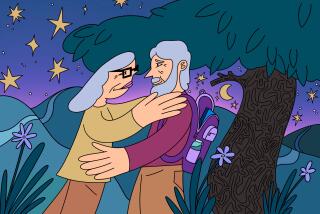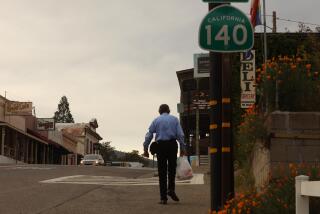Vision of Friends Lighted Her Way Home
It was morning in Los Angeles when I placed the call. In Falmouth, England, it was nearly tea time.
The line was bad and Kathleen Pacey, 94, is hard of hearing.
“Hello,” I said.
“Hello?”
“Hello!”
“Hello?”
“HELLO!” We went on like that for awhile and Kathleen started to laugh. She doesn’t know me, so I shouted an introduction, then made loud small talk.
“WHAT HAVE YOU BEEN DOING TODAY?”
“Oh, I’ve been knitting this morning. I had a nice meal at 12:30, and now I’ve been doing a bit of gossiping.”
Then she laughed some more. We’d only chatted a few minutes before the director of the Bethany Christian Retirement Home was on the line, yammering about how this interview should have been arranged through a social worker and blah, blah, blah. It’s so nice to bump into bureaucrats on international calls.
My main task, however, had been accomplished. I’d spoken with Kathleen Pacey and she sounded positively chipper. Yes, she was very happy to be back home in England, in the hometown where her husband is buried. Were it not for her friends at an agency called Visually Handicapped Adults of the Valley, Kathleen might still be glum in Los Angeles.
To Ruth Osias, the story of Kathleen’s homecoming is a reminder that, though this city often seems hard-bitten and uncaring, “kindness, compassion and caring are still alive and well in L.A.” Many people, she says, “went out of their way and took it upon themselves to care for this little 94-year-old blind lady from England.”
The story, for all practical purposes, begins back in Falmount in the early 1980s. A degenerative condition had claimed the sight in one of Kathleen’s eyes, and then a freak accident cost her the other. After her husband’s death, she moved to Los Angeles to live with her son and his wife.
Kathleen found life here lonely. There were strains between her and her daughter-in-law. Although she had lived in the San Fernando Valley for years, she didn’t become involved with Visually Handicapped Adults until 1993. The program, informally called “the blind center,” meets three days a week at St. Andrews Church in Van Nuys, offering classes in weaving, knitting, macrame and ceramics. A bowling team plays weekly.
Ruth Osias, a retired occupational therapist, had been a volunteer with the program for eight years, along with her husband, Eddie. “I know if I was blind, I’d be a real bitch,” Ruth says. What impressed her initially, and made her keep returning, was the spirit of the client. “They’re so appreciative of everything. . . . What we mostly give is TLC, because that’s what they want and that’s what they give back.”
It’s been a little more than a year since Ruth got to know the tiny, white-haired woman who walked with a cane and, despite her blindness, always felt more comfortable wearing her little granny glasses. As they talked, Ruth learned of Kathleen’s sadness and her longing to return to a familiar place she could envision in her mind’s eye. But money was a problem, and her blindness also complicated matters. Where would she live? How would she take care of herself?
Over the next year, making Kathleen’s dream come true became Ruth’s mission. She found plenty of people willing to help.
At the British consulate, Ruth found Fiona Hilyer, who made connections with Cornwall County social worker Chris Sweet, who set out to find suitable quarters for Kathleen back home. At Virgin Airlines, Ruth found sympathetic officials who arranged for free air fare not just for Kathleen, but for the escort who would be needed to travel with her.
Arrangements were falling into place, but there were concerns about Kathleen’s health. A Northridge physician, Dr. Duru Talreja, discovered that Kathleen’s blood pressure was so high she was at imminent risk of stroke. Dr. Talreja prescribed medication that brought her blood pressure down. “She saw her three times, charging so little it was farcical,” Ruth says.
As the travel date approached, Jean Chiampa, an administrative aide with the Visually Handicapped Adults, and volunteer Shirley Johnstone were busy writing and faxing letters to Chris Sweet in England, coordinating Kathleen’s itinerary.
Finally, on April 2, a bon voyage party was held at St. Andrews. Then the Osiases drove Kathleen and escort Peggy Burke to the airport. Peggy, a vibrant 89 and English herself, happily volunteered. She carried with her four letters, written by Ruth, to inform Kathleen’s friends in Falmouth of her return. All have since visited Kathleen.
“The way it all came together,” Ruth says now, “was just remarkable,” Ruth says.
It would have been nice to have had a longer chat with Kathleen, over a better phone line. Perhaps I should have called Chris Sweet, but deadlines are deadlines. Fortunately, my colleague, Erin Texeira, had reached Kathleen a week earlier.
“There is just nothing like jolly old England,” she told Erin. “Not the royals. I don’t care much about them. But I just love it here. . . .
“I miss California. The weather was nice there, and I miss my friends at the blind center. But there is nothing like home. . . .
“It was so nice that everyone arranged for me to come back home. I was not sure I would ever get home again.
“And now, it’s wonderful.”
More to Read
Sign up for Essential California
The most important California stories and recommendations in your inbox every morning.
You may occasionally receive promotional content from the Los Angeles Times.










